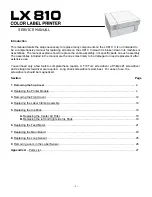
Programming Codes
T480
Programmer’s Guide
Page
84
Rev A
100-14362
Function
Load item from user store
ASCII
[ESC] [US] l <Name..> <0>
If the item referenced is a user-defined character set, it is loaded into the
current definition. If it is a macro, it is loaded into the macro buffer. It is
not processed or printed.
To help maintain the user-store area, the following commands can be
used.
The terminating <0> may be replaced with an & or redefined. See [ESC]
[EM]T<n> or &%UT<n> on page 88.
Function
Flag as a start-up macro
ASCII
[ESC] [US] s <Name..> <0>
The [ESC] [US] s <Name..> <0> command flags the referenced item to be
processed at startup. No more than one user character definition and user data item
may be flagged.
The terminating <0> may be replaced with an & or redefined. See [ESC]
[EM]T<n> or &%UT<n> on page 88.
Function
Remove item from user store
ASCII
[ESC] [US] e <Name..> <0>
The [ESC] [US] e <Name..> <0> command removes an item from user
store and frees up its space. The terminating <0> may be replaced with
an & or redefined. See [ESC] [EM]T<n> or &%UT<n> on page 88.
Function
Flush information from user store
ASCII
[ESC] [US] f ALL <0> Base User Store
or
[ESC] [US] f EXT <0> Extended User Store.
Description
The [ESC] [US] f ALL <0> command clears all of the information to the
user store and frees the data space. The [ESC] [US] f EXT <0> command clears all of
the information in the extended the user store.
The terminating <0> may be replaced with an & or redefined. See [ESC] [EM]T<n> or
&%UT<n> on page 88.
Function
Report on user store
ASCII
ESC] [US] q <0>
Description
The [ESC] [US] q <0> prints or returns information about the contents of
and available space in user store.
Note:
A configuration option is available that locks the user store data.
The configuration option prevents the occurrence of new user store data
operation until the lock is manually reset and accidental deletion of the
saved information. The user-defined character buffer and/or user data
buffer may be redefined and used but cannot be stored.
The terminating <0> may be replaced with an & or redefined. See [ESC] [EM]T<n> or
&%UT<n> on page 88.
















































